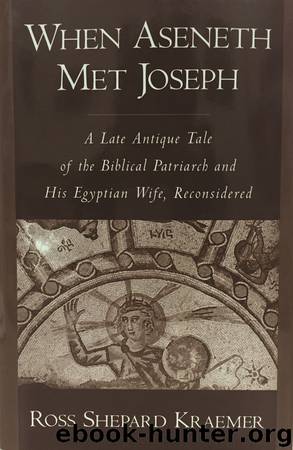When Aseneth Met Joseph by Kraemer Ross Shepard;

Author:Kraemer, Ross Shepard;
Language: eng
Format: epub
Publisher: Oxford University Press, Incorporated
Published: 2015-07-08T16:00:00+00:00
NOTES
1. S. Mitchell, Anatolia, 43.
2. Ample useful documentation can be found in Mitchell, Anatolia, 43–51, particularly of evidence from Asia Minor.
3. Mitchell, Anatolia, 45.
4. On angel worship in Asia Minor, see not only Mitchell, Anatolia, but also F. Sokolowski, “Sur le culte d’angelos,” 225–29, and Sheppard, “Pagan Cults,” 77–101; see also Kearsley, “Angels,” 206–9.
5. Mitchell, Anatolia, 45, with references in n. 262; texts from Louis Robert, “Reliefs, votifs et cultes d’Anatolie,” Anatolia: Revue Annuelle d’Archéologie 3 (1958): 115 = Louis Robert, Opera Minora Selecta: Epigraphie et antiquités grecques, 7 vols. (Amsterdam: A. M. Hakkert, 1969–90), 1:414: θε ὐψιστ καì θει αγγελ and elsewhere.
6. Mitchell, Anatolia, 46. It is precisely the widespread use of such language that creates some severe problems in the indentification of such materials as “pagan,” Jewish, or Christian, as Mitchell himself acknowledges. Noting that Jews and pagans in Lydia and Phrygia both worshiped “a wrathful god of Justice, to be appeased not only by adhering to divine law but by songs of praise” and that they shared both religious values and religious terminology, particularly the use of εὐλογία and εὐλογέω (terms that occur twenty-four times in Philonenko’s shorter text and thirty-two times in Burchard’s longer reconstruction), Mitchell writes: “In such an environment contemporaries may have been as hard pressed as modern scholars to ascertain whether a dedication to the highest god was the work of a pagan or a Jew” (Anatolia, 37; see also 48).
7. Mitchell, Anatolia, 34, fig. 16: from G. E. Bean, “Notes and Inscriptions from Pisidia, II,” Anatolian Studies 10 (1960): 70, n. 122; Robert, BE 1961: 750, 1965: 412. The inscription is discussed on p. 49, as part of his treatment of the cults of Theos Hypsistos; he argues that the concept of Hagia Katafyge is derived from the Jewish Psalms but offers no specifics.
8. So, once again, Goodenough: “The phenomenon of astralism ... along with Neoplatonism was becoming the great religious reform of late paganism” (Jewish Symbols, 12:152).
9. In addition to various editions of ancient texts, there is an extensive scholarship on Neoplatonism. Classic studies in English include A. H. Armstrong, Cambridge History of Later Greek and Early Medieval Philosophy (Cambridge: Cambridge University Press, 1970); R. T. Wallis, Neoplatonism (London: Duckworth, 1972); and J. M. Rist, Plotinus: The Road to Reality (Cambridge: Cambridge University Press, 1977). More recent studies, with further bibliography, include John Peter Kenney, Mystical Monotheism: A Study in Ancient Platonic Theology (New Hampshire: University Press of New England, 1991); A. C. Lloyd, The Anatomy of Neoplatonism (Oxford: Clarendon Press, 1990); Gary M. Gurtler, Plotinus: The Experience of Unity (New York: Peter Lang, 1989); Robert M. Berchman, From Philo to Origen: Middle Platonism in Transition (Chico, CA: Scholars Press, 1984); Robert Lamberton, Homer the Theologian: Neoplatonic Allegorical Reading (Berkeley, CA: University of California Press, 1986); Gregory Shaw, Theurgy and the Soul: The Neoplatonism of lamblichus (State College: Pennsylvania State University Press, 1995); R. T. Wallis, ed., Neoplatonism and Gnosticism (Albany: State University of New York Press, 1992); see also S. Lilla, “Platonism and the Fathers,” EEC 2:689–98.
Download
This site does not store any files on its server. We only index and link to content provided by other sites. Please contact the content providers to delete copyright contents if any and email us, we'll remove relevant links or contents immediately.
| Ancient & Classical | Arthurian Romance |
| Beat Generation | Feminist |
| Gothic & Romantic | LGBT |
| Medieval | Modern |
| Modernism | Postmodernism |
| Renaissance | Shakespeare |
| Surrealism | Victorian |
4 3 2 1: A Novel by Paul Auster(11791)
The handmaid's tale by Margaret Atwood(7450)
Giovanni's Room by James Baldwin(6810)
Asking the Right Questions: A Guide to Critical Thinking by M. Neil Browne & Stuart M. Keeley(5357)
Big Magic: Creative Living Beyond Fear by Elizabeth Gilbert(5353)
Ego Is the Enemy by Ryan Holiday(4958)
On Writing A Memoir of the Craft by Stephen King(4664)
The Body: A Guide for Occupants by Bill Bryson(4584)
Ken Follett - World without end by Ken Follett(4444)
Bluets by Maggie Nelson(4261)
Adulting by Kelly Williams Brown(4235)
Eat That Frog! by Brian Tracy(4149)
Guilty Pleasures by Laurell K Hamilton(4118)
White Noise - A Novel by Don DeLillo(3829)
The Poetry of Pablo Neruda by Pablo Neruda(3816)
Fingerprints of the Gods by Graham Hancock(3738)
Alive: The Story of the Andes Survivors by Piers Paul Read(3731)
The Book of Joy by Dalai Lama(3698)
The Bookshop by Penelope Fitzgerald(3619)
